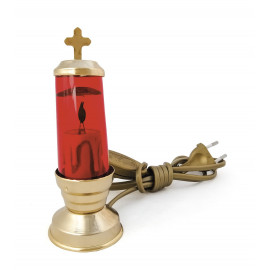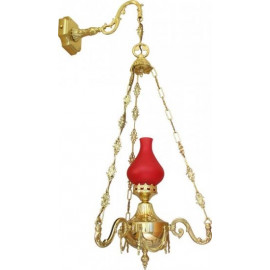No products
Product successfully added to your shopping cart
There are 0 items in your cart. There is 1 item in your cart.
Sanctuary Lamp
- Altar Bell and Gong
- Candle Snuffer
- Candlestick
- Catholic Pyx
- Chalices
- Church wall lamps
- Ciborium
- Crosses and Crucifix
- Cruets & Trays
- Holy Water Font
- Holy Water Pot
- Missal Stand
- Monstrance Tabor
- Monstrances
- Offering Baskets
- Oil Stock
- Patens
- Reliquaries
- Sanctuary Bells
- Sanctuary Lamp
- Sprinkler
- Thurible, Boat, & Spoon
- Travel Liturgy & Mass Kit
A sanctuary lamp, also known as a chancel lamp, altar lamp, everlasting light, or eternal flame, is a light that shines before the altar of sanctuaries in many Jewish and Christian places of worship. The sanctuary lamp is known by its Hebrew name, Ner Tamid, in Judaism, and is hung or placed in front of the ark in every Jewish synagogue. It is meant to represent the menorah of the Temple in Jerusalem, as well as the continuously burning fire on the altar of burnt offerings in front of the Temple. The sanctuary lamp symbolizes God's eternal presence and is therefore never extinguished. In Roman Catholic churches, the sanctuary lamp is placed before the tabernacle or aumbry as a sign that the Lord is present, and in Old Catholic and Anglican churches as a sign that the Blessed Sacrament is reserved or stored. The sanctuary lamp is also found in the chancel of Lutheran and Methodist churches to indicate the presence of Christ in the sanctuary, as well as a belief in the Real Presence of Christ in the Eucharist. The sanctuary lamp may also be seen in Eastern Orthodox Churches. Other Christian denominations burn the lamp to show that the light of Christ always burns in a sin-darkened world. The sanctuary lamp is usually fueled by oil or wax, but electric sanctuary lamps are also used.
A sanctuary lamp, also known as a chancel lamp, altar lamp, everlasting light, or eternal flame, is a light that shines before the altar of sanctuaries in many Jewish and Christian places of worship. The sanctuary lamp is known by its Hebrew name, Ner Tamid, in Judaism, and is hung or placed in front of the ark in every Jewish synagogue. It is meant to represent the menorah of the Temple in Jerusalem, as well as the continuously burning fire on the altar of burnt offerings in front of the Temple. The sanctuary lamp symbolizes God's eternal presence and is therefore never extinguished. In Roman Catholic churches, the sanctuary lamp is placed before the tabernacle or aumbry as a sign that the Lord is present, and in Old Catholic and Anglican churches as a sign that the Blessed Sacrament is reserved or stored. The sanctuary lamp is also found in the chancel of Lutheran and Methodist churches to indicate the presence of Christ in the sanctuary, as well as a belief in the Real Presence of Christ in the Eucharist. The sanctuary lamp may also be seen in Eastern Orthodox Churches. Other Christian denominations burn the lamp to show that the light of Christ always burns in a sin-darkened world. The sanctuary lamp is usually fueled by oil or wax, but electric sanctuary lamps are also used.
Sanctuary Lamp There are 12 products.
The Significance of the Church Sanctuary Lamp
The church sanctuary lamp is a beacon of faith, a silent yet profound herald of the divine presence in Christian places of worship. This lamp, often encased in red glass, holds a position of prominence within the sanctuary, its steady flame a constant reminder of the sacred that dwells within.
Understanding the Church Sanctuary Lamp
Historical Roots and Symbolism
The tradition of the church sanctuary lamp has deep historical roots, tracing back to ancient Jewish customs. In the Old Testament, God instructed Moses to keep a lamp burning perpetually in the Tabernacle, a command that symbolizes God's eternal presence. This practice was adopted by early Christians and has since become a staple in churches worldwide, evolving from oil lamps to the now more commonly used candles.
The Lamp as a Symbol of Christ's Presence
In Catholic churches, the sanctuary lamp serves a specific purpose: it signifies the Real Presence of Christ in the Eucharist. When the lamp is lit, it indicates that the consecrated hosts, believed to be the body of Christ, are present in the tabernacle. This visual cue invites worshipers into a state of reverence and adoration.
The Lamp's Role Across Christian Denominations
While most associated with Catholicism, the church sanctuary lamp is also found in various Christian denominations, including Eastern Orthodox, Anglican, and some Lutheran churches. Each tradition may have its unique interpretation, but the common thread is the representation of God's unending presence and the light of Christ in a world often shrouded in spiritual darkness.
The Church Sanctuary Lamp in Practice
Placement and Design
The placement of the church sanctuary lamp can vary. It may be suspended by a chain, affixed to a wall, or placed on a stand near the tabernacle or altar. The design of the lamp itself is often simple, yet its location and the act of keeping it lit are imbued with profound theological significance.
The Lamp's Color and Materials
While red is the most common color for the glass encasing the lamp, symbolizing the blood of Christ and distinguishing it from other votive lights, this is not a strict requirement. The materials used for the lamp can range from brass to silver, each adding to the aesthetic and spiritual ambiance of the sanctuary.
The Role of the Lamp in Worship
The church sanctuary lamp is not merely a decorative element; it plays an integral role in worship. It serves as a focal point for prayer and meditation, reminding the faithful of the light of Christ that guides and enlightens. Its presence is a call to worship, a silent invitation to turn one's heart towards the divine.
FAQs About the Church Sanctuary Lamp
What does the church sanctuary lamp symbolize?
The church sanctuary lamp symbolizes the presence of Christ in the Holy Eucharist and serves as a reminder of God's eternal presence and the light of Christ in the world.
Why is the church sanctuary lamp red?
The red color is widely used to distinguish the sanctuary lamp from other lights and to symbolize the blood of Christ, though the color is not mandated by church law.
Is the church sanctuary lamp unique to the Catholic Church?
No, while it is most commonly associated with Catholicism, the church sanctuary lamp is also present in Eastern Orthodox, Anglican, and some Lutheran churches, each with its own theological emphasis.
What happens if the church sanctuary lamp goes out?
If the church sanctuary lamp goes out, it is typically relit as soon as possible. The lamp going out does not change the fact of God's presence, but it does serve as an important symbol for the faithful.
Can the church sanctuary lamp be electric?
Yes, while traditionally fueled by oil or wax, modern adaptations may include electric lights, especially in places where maintaining a flame is not feasible.
In conclusion, the church sanctuary lamp is a small yet powerful symbol that carries with it centuries of tradition and deep spiritual meaning. Its flame, a testament to the enduring presence of the divine, beckons the faithful to remember, reflect, and revere the sacred mysteries of their faith.












